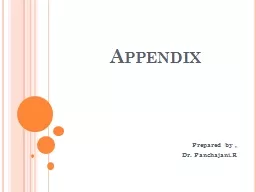

PanchajaniR APPENDIX Anatomy Narrow hollow tube closed at one end situated in the right illiac fossa and that protrudes from the postero medial aspect of caecum 2cm below the insertion of the ID: 920844
Download Presentation The PPT/PDF document "Appendix Prepared by , ..." is the property of its rightful owner. Permission is granted to download and print the materials on this web site for personal, non-commercial use only, and to display it on your personal computer provided you do not modify the materials and that you retain all copyright notices contained in the materials. By downloading content from our website, you accept the terms of this agreement.
Slide1
Appendix
Prepared by ,
Dr.
Panchajani.R
Slide2APPENDIX
Anatomy
Narrow hollow tube , closed at one end
situated
in the right
illiac
fossa
and that protrudes from the
postero medial
aspect of
caecum
2cm below the insertion of the
illeum
in to
caecum
.
3 -4 inches (8-10cm) long
it
has mucosal ,
submucosal
, muscular and serous layers .
At
birth it is short and broad , tubular structure by about the age of
2
in
childhood it continue to grow of the
caecum
and commonly rotates the Appendix in to
retrocaecal
position
at
the base of the Appendix is constant.
Slide3APPENDIX
Various positions:-
Retrocaecal-74%, pelvic - 21%,.
Subcaecal
-2%, post
illeal
- 0.5%, pre
illeal
- 1% .
Arterial supply:-
Appendicular
artery branch of
ileocolic
artery
Venous ;-
.
Appendicular
vein
Functions;-.
Maintaining gut flora, important in maintaining B cell mediated immune responses, movement and removal of waste matter in the digestive system .
Slide4Appendicitis
It
is the inflammation of the Appendix
.
Acute
or chronic .
Begins in inner layer of Appendix then spreads to other parts .
It
is one of the common cause of abdominal pain.
Aetiology ;-
No unifying cause .
Decreased
dietary fibre and increased consumption of carbohydrates.
Blockage of the
Appendicular
luman
by
faecolith
, tumour of
caecum
, intestinal parasites.
Slide5Pathology
Luminal obstruction (
faecolith
) leads to bacterial overgrowth results in inflammation and swelling (Mucosal ulceration ) .
Appendix become inflamed and filled with pus which results in increased pressure and localised ischemia.
If not treated it can rupture .
perforation leads to local abscess formation and peritonitis , shock and may leads to death.
Slide6Clinical features
Abdominal
pain
- pain begins around the umbilicus ,as the inflammation progresses .the pain localised in the right
illiac
fossa
as the peritoneum becomes inflamed , it results in rebound tenderness . Pain aggravation from movement
.
Maximum tenderness/pain in the Mc.
Burney,s
point.
Site of pain may vary depending up on the position of Appendix.
Anorexia, nausea,
vomiting
Fever
initially low grade fever that may worsen as the illness progresses.
Slide7Signs
Localised
tendernes
in right
il
liac
fossa
muscle guarding
rebound tenderness.
Maximum
tenderness in the
Mc.burneys
point
Hyperesthesia in
sherran's
triangle
Rovsing’s
sign positive
Psoas
sign positive in
retrocaecal
Appendix,
obturator
sign positive in pelvic Appendix.
Slide8Diagnosis and treatment
Diagnosis
Blood
;- increased WBC, ESR
USG
Contrast CT
Surgery:-
Appendicectomy
:- laparoscopic / conventional
Complications
of appendicitis:-
Perforation
Appendicular
abscess
Risk
factors for perforation:-
Extremes
of age,
immunosuppression
, Diabetes,
faecolith
obstruction, pelvic Appendix, previous abdominal surgery.
Slide9Appendicular mass (phlegmonosmass
)
It is an inflamed Appendix with an adherent
omentum
and small bowel.
ie
, greater
omentumand
loops of small intestine are adherent to the inflamed Appendix
.
Between 2-6% of patients with acute appendicitis presents with
Appendicular
mass
.
It can usually felt after 24-48hrs of onset of pain &becomes well defined by 4
th
or 5
th
day and there after it resolves or forms an abscess.
Treatment
;- conservative treatment , medicinal treatment,
Monitoring the general state of the patient and vital signs regularly. The presence of worsening of symptoms or signs is an indication for surgical treatment.
Slide10Appendicular abscess
Rare, it is the collection of pus resulting from the inflammation of appendix
.
It is a life threatening complication of acute appendicitis
.
Abscess is formed around the Appendix.
Treatment
:- Drainage of pus under radiological guidance
Slide11Chronic appendicitis
Long term condition characterised by
recurrent
attack of acute appendicitis. Symptoms that come and go
.
Symptoms may be mild
.
Most common symptom is abdominal pain (right lower quadrant ).
sharp,dull
pain sometimes continues for more than 48hrs or weeks
.
other
symptoms are fever, swelling, tenderness, fatigue,
malaise.
Cause is like that of acute appendicitis inflammation and obstruction of Appendix by
faecolith
, parasites, tumours, foreign bodies etc
..
Slide12Chronic appendicitis
Diagnosis
is difficult and it includes history, physical
examination,CT
, MRI etc.. and rule out the other conditions by blood test, urine analysis, abdominal USG, X-ray etc..
The most common treatment is
appendicectomy
Most common complications are acute appendicitis, rupture, abscess, peritonitis, sepsis.
Slide13Appendicitis therapeutics
Iris
tenax
Aconite
Belladonna
Colocynth
Echinace
Colchicum
Nux
vomica
Plumbum
met